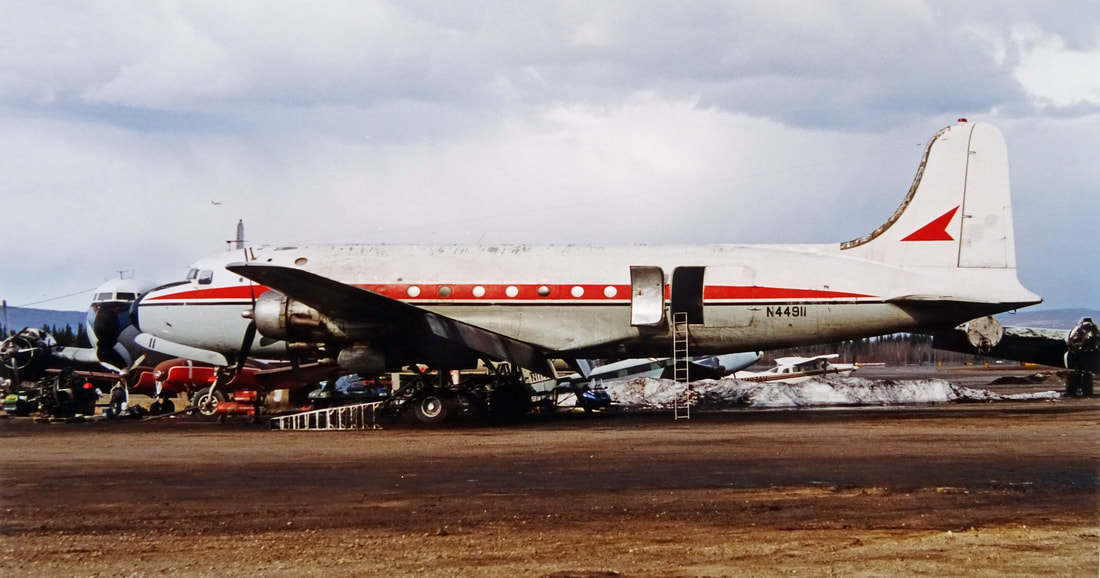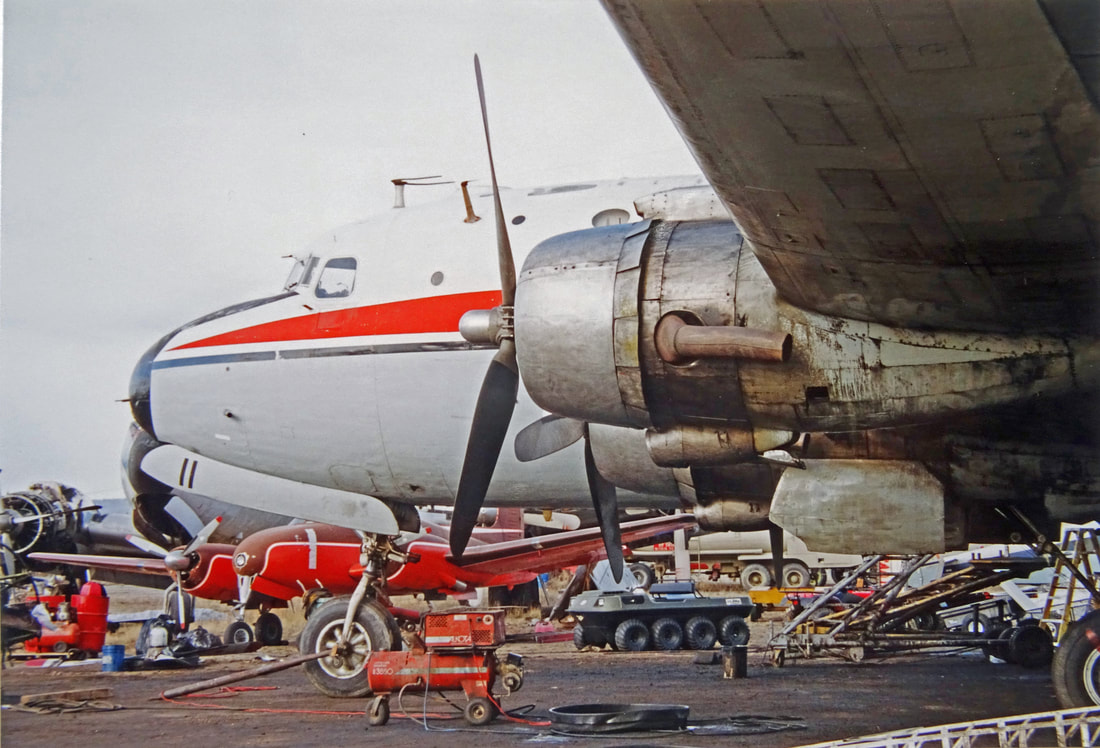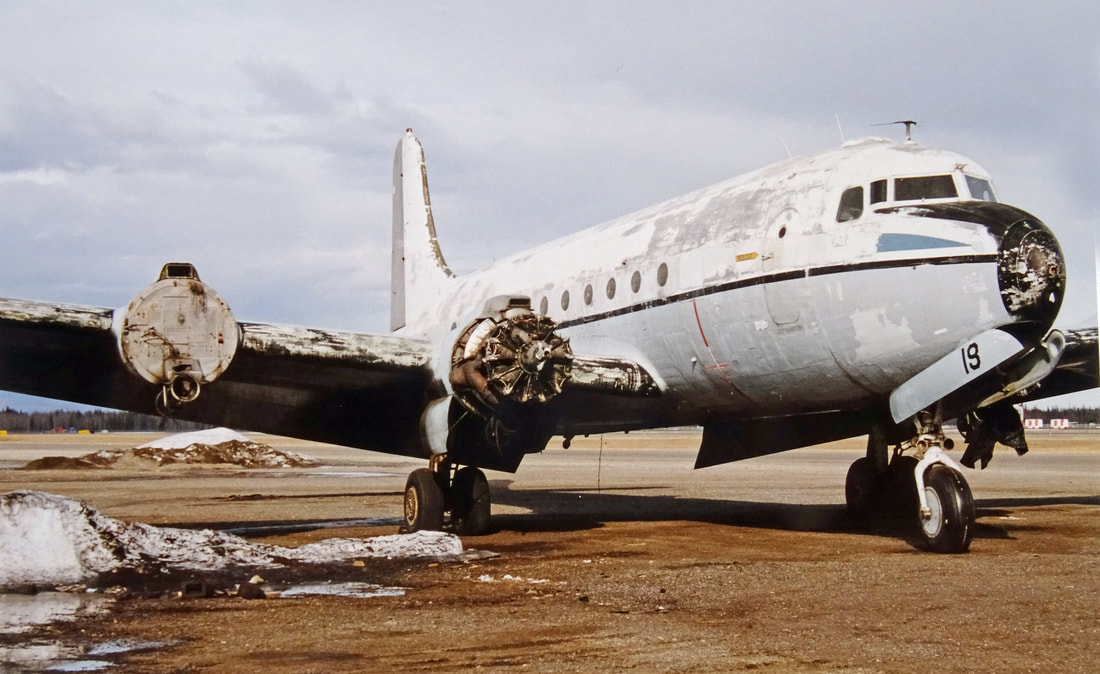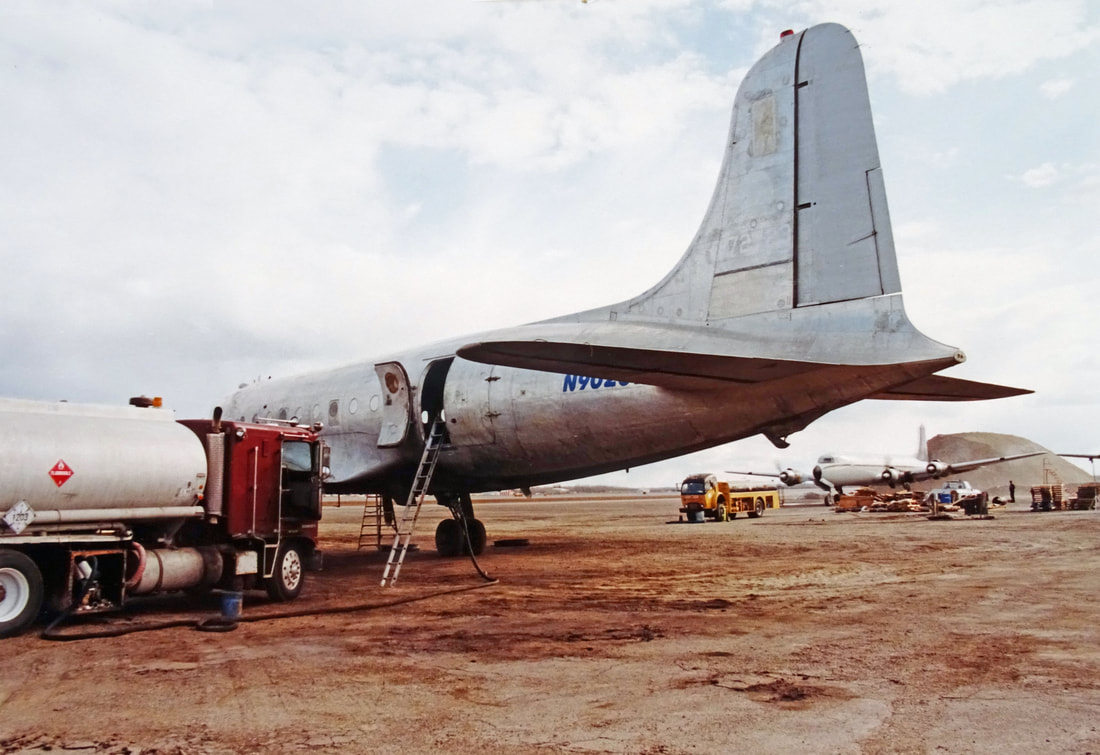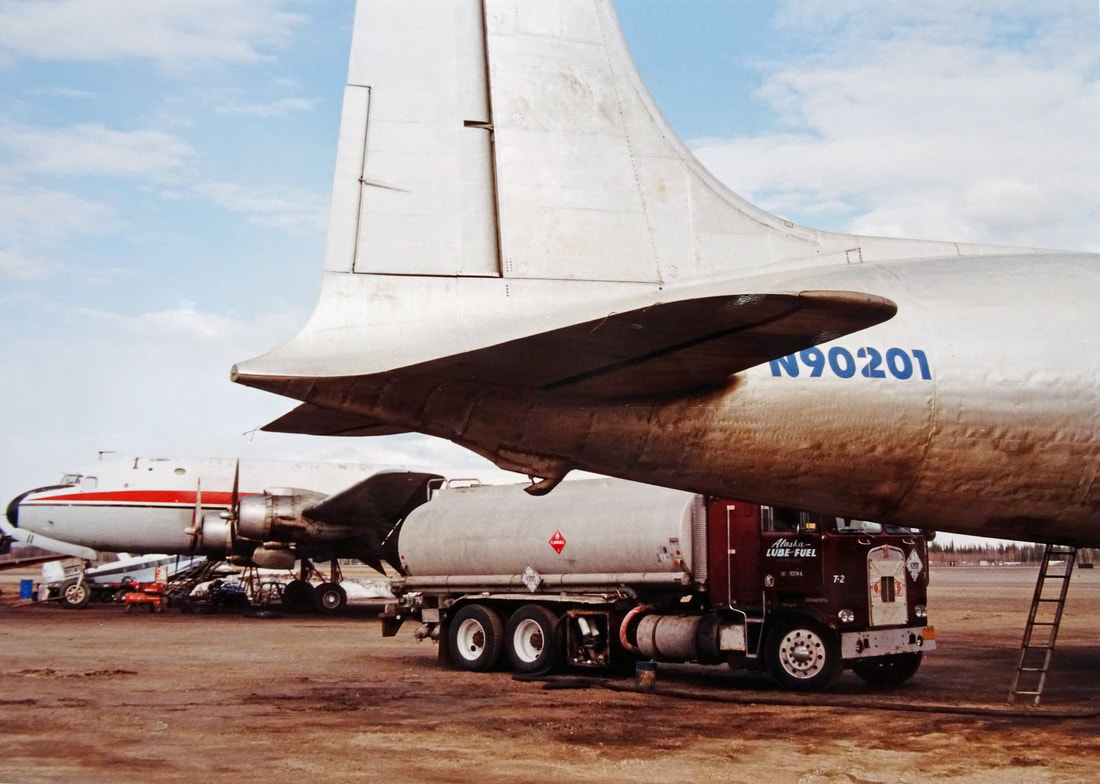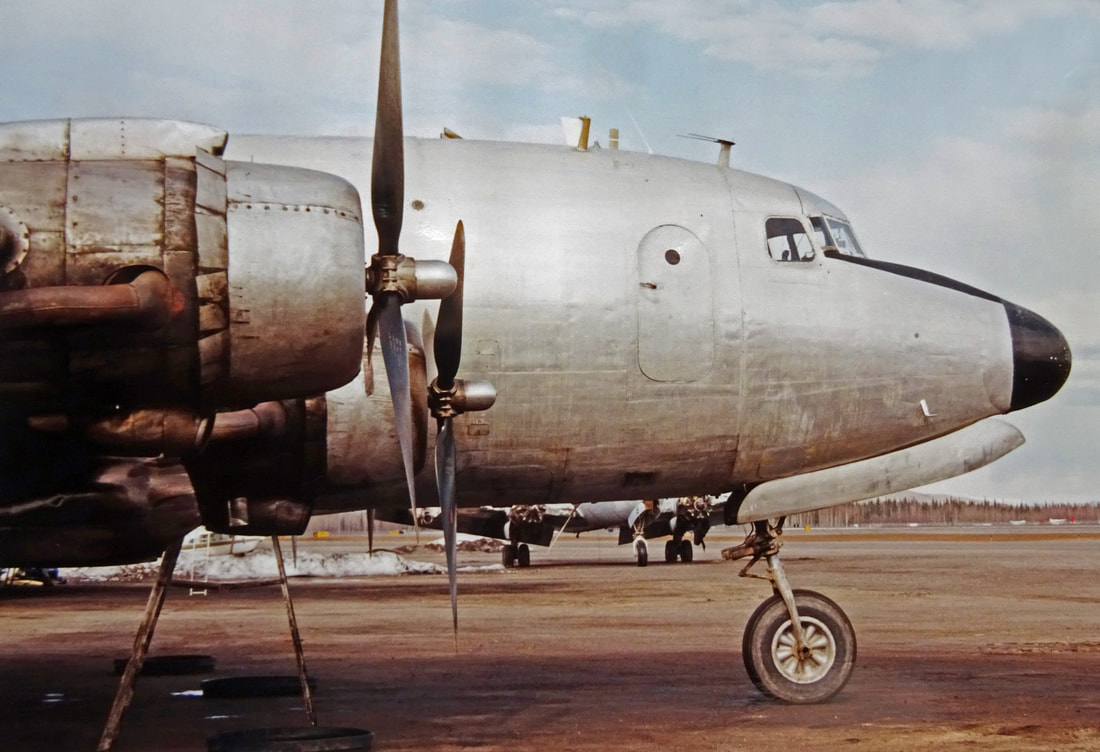- Brooks Fuel -
Fairbanks, Alaska
By Jan Koppen
When working for KLM Cargo, one is always surrounded by the modern screaming jets. Once a while, the need for some aviation nostalgia must be fulfilled. Nowadays, the choice is limited. Fortunately, Alaska is a land with still a good number of operational Big Props. In April 2000, I decided to visit this Greatland.
The pics are digital copies of paper photos, so quality low, but what does it matter? It goes about the experience!
The pics are digital copies of paper photos, so quality low, but what does it matter? It goes about the experience!
During the mid 80's untill the early months of 2011, Brooks Fuel, Inc. delivered fuel to rural communities and miners using large aircrafts.
|
Brooks Fuel was runned as a family-owned business which started operation in 1986. The company employees worked year-round to supply interior Alaska communities and business operations with heating fuel, aviation gas and jet fuel.
Brooks Fuel mainly flew two C-54’s in Alaska to supply fuel for villages and remote mines far off the road and water systems. Communities near rivers and along the coast generally have a year’s supply of fuel barged in during the summer months. Those away from the waterways must rely on flight deliveries. Brooks is also known as a supplier for mining operations. They supplied mines with fuel and did some cargo hauling as a certified part 125 carrier. The flying fuel company was an outgrowth of Coghill’s Nenana Fuel Co. Brooks, originally from Idaho, took over fueling from the Nenana-based company when he was able to purchase aircraft. Mr. Brooks got his license in 1964 and had accrued 23,000 hours flying since then. His curiosity and fascination with legacy cargo aircraft started when he was a crew chief on Huey helicopters during the Vietnam War. The company has several DC-4’s laying in salvage to supply parts for the flying aircraft. Brook Fuel’s experience with its legacy aircraft was known worldwide. The company staff knew thier aircraft, they had hand picked those DC-4/C-54's they were using because of known corrosion problems on some models. The DC-4 was the perfect aircraft for Brook Fuel activities in Alaska. The DC-4 is a self-contained aircraft that requires very little support, lands on short gravel strips, beaches and river drainages. Brooks Fuel stopped operating in 2011, due to multiple FAA issues and other business matters. In 2019 it seemed that Brooks yard was being cleaned out. |
A 1950’s DC-4 propliner sat on the ramp with one of its engine nacelles pulled off for a quick repair. The company mechanic, donned in jeans, a shirt and lace-up boots and covered from head to toe in black oil and grease, ran from the shop to the ramp with a part in hand, on his way toward what was one of the last DC-4 aircraft to be used commercially in the U.S.
The colourscheme of N44911 still dates from its days of operation with Biegert Aviation. During the 1990's Brooks Fuel bought several of these former Biegert Aviatiation Skymasters, after a long time storage at Chandler, Arizona.
In April 2000, DC-4 N90201 and N44911 earned their keep for Brooks Fuel. Fuel was flown to the many isolated communities and refuelling points for the oil exploration helicopters. The airfields are often very primitive and even a DC-4 looks big on some of them!
'Nine-Eleven' was getting its ration of fuel and oil; it must be neckbreaking to climb on that wing during wintertime.
This WW2-vintage transport was delivered as '42-72356' to the US Army Air Force. It's military career came to an end in the desert of Davis Monthan AFB, Arizona, in March 1973. She started a civil career as N44911 for Biegert Aviation upon its purchase in October 1975. In 1996 it went from the desert to Brooks Fuel Inc. in ice-cold Alaska.
On May 7, 2004, about 21:30 hours Alaska daylight time, the crew 'N44911' was beginning engine start procedures at the Ganes Creek Mine airstrip (an airstrip with a 4.200ft runway at a private gold mine, at about 25 miles west of McGrath, Alaska). They successfully started engines number 4,3, and 2 in succession. As the crew started engine number 1, an explosion occurred in the wing area between engines 1 and 2. The explosion was of such force that engine and left wing seperated from the aircraft. The crew applied engine power in the remaining engines and taxied away from the area of the explosion. The crew then stopped about mid-field and disembarked the unlucky airplane.
The weather-beaten nose of this veteran still wear the remnants of T&G Aviation red color scheme.
Douglas DC-7C N90251 was delivered new to Transports Aeriens Intercontinentaux in January 1958 as F-BIAQ. During 1963 it was stored at Le Bourget, Paris. The next year it went to work for L'Armee de L'Air as 45367/85-CB. In December 1978 she was exported back to the US and GCA became the new owner, who registered her as N90251. GCA leased the 'Seven-Seas' to Petroleum Air Transport for an undefined period. Commercial Leasing became the next owner in July 1982. Four years later she was acquired by T&G Aviation and finally Roger Brooks bought her in February 1995. Brooks operated the '7C' for some 400 hours in during 1995/1996.
The Douglas DC-7C was the extended range variant and was the last big propliner before the jet age.
Brooks Fuel kept Alaska supplied using legacy aircraft.
Hundreds of small villages and mines are dependent upon air transport for vital supplies and fuel to power vehicles and heat buildings.
The fuel truck is a White Motor Company Model 3000 from the 50's.
N99212 started life with the USAAF as '42-72556' and then with the US Navy before it eventually found its way up to Brooks.
Wings-clipped Air North DC-3 N99460 at the Brooks Fuel yard on May 01, 2000.
|
Douglas C-47A N95460. It is seen here in the yard of Roger Brooks at Fairbanks, Alaska, in April 2000. It had been sitting at Fairbanks for quite a long time. This airframe started its career as '43-15724' with the USAAF in 1944. It went to Alaska ATC in 1944 and as NC95460 to Northern Consolidated Airlines in 1953. From 1967 to 1971 it went to Interior Airways, which operated out of Fairbanks. Later in her career she operated for Yukon Air Service before being registered to Air North in 1977.
|
N67018 shows her age and must have quite a life on the clock when I photographed her at Brooks Fuel yard on May 01, 2000.
Brooks Fuel Douglas C-54Q-DC Skymaster N67018. This aircraft was constructed as a C-54D-15-DC for the United States Army Air Force (serial 43-17246). Then leaving the factory it was immediately transferred to the US Navy with BuNo 56544 on October 1, 1945. Here it was redesignated R5D-3. It was later converted to a C-54Q and served with the US Marine Corps, before being stored at Davis-Monthan Air Force Base in Arizona in September 1971. It was brought back to life by Aircraft Specialities Inc. in 1977, with the civil registration N67018, sold to Globe Air Inc. in 1981 and Sanders Lead Co. in 1986. Brooks Fuel bought it in November 1996 and used it for spare parts. It was still painted in USMC-colours, although very faded and patchy.
Scavenged and in state of decay like so many aircraft at Fairbanks in the year 2000.
A Kenworth on the left and a White 3000 from the 50's on the right.
UN1203, on the white plate of the left truck, is the UN number for gasoline as a dangerous good. In the background, sharing the overcast, is an Everst Air Cargo DC-6.
The four engine aircraft was carrying 3,000 gallons of heating fuel.
Some wear and tear but basically N90201 was in pretty good shape during my visit.
N90201 is seen here prepped for another fuel delivering flight. She started her career as a C-54G with USAAF in 1945 as '45-0476'.
The men had to work fast. The aircraft was needed soon for another mission. They made one, to two flights a day in the winter and flew as many as four flights in the summer, depending on forest fires and game surveys. Brooks Fuel had set up refueling stations at remote runways and locations and supplied those with fuel as needed.
The sturdy DC-4 was the ideal plane for Brooks Fuel.
The history of this Douglas C-54D is as follows; - She was delivered in June 1945 to U.S. Army Air Force and she even participated in the Berlin Airlift. After retirement from the military she was sold on the civilian market. During the following years she saw service with Aero Union Corp., Honda Carib Cargo Inc., Great Soutern Airlines, before being bought by Brooks Fuel in February 1994.
The east ramp at Fairbanks International Airport, may looked to some, like a graveyard of 1940’s and 50’s aircraft, but in reality, the aging planes supplied Bush Alaska with fuel for heat and transportation.
As late as November 1987, this aircraft operated for Great Southern Airlines a commercial flight from Ostend, Belgium, across the Atlantic to the USA, with a fuel-stop in Keflavik!
N90201 approaches Fairbanks out of a dramatic Alaskan CB front.
Brooks Fuel C-54D N90201 settling in for a landing on Fairbanks airport during April 2000.
On this spring day, N90201 is seen here returning from the interior, where it dropped off a load of fuel for a village.
Note; - The exhaust stain is from the Janitrol combustion heater.
- The End -



